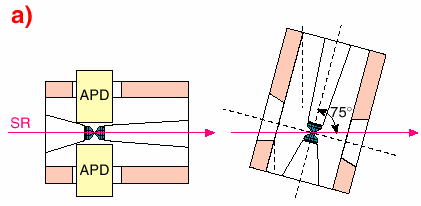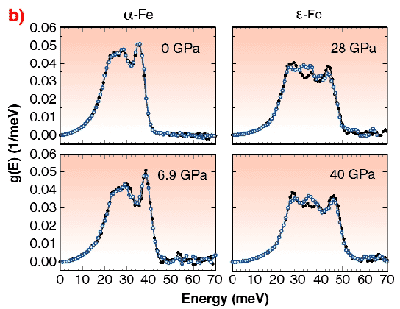- Home
- Users & Science
- Scientific Documentation
- ESRF Highlights
- ESRF Highlights 2000
- Electronic States and Lattice Dynamics
- High-Pressure Phonon Spectroscopy of Oriented hcp Iron
High-Pressure Phonon Spectroscopy of Oriented hcp Iron
At ambient pressure and temperature, iron is magnetic and crystallises in the cubic (bcc) structure (![]() -Fe). Around 13 GPa,
-Fe). Around 13 GPa, ![]() -Fe transforms to nonmagnetic
-Fe transforms to nonmagnetic ![]() -Fe. This hexagonal (hcp) high-pressure phase is the most relevant constituent of the Earth's inner core. The thermodynamic and elastic properties of this phase are therefore of actual geophysical interest.
-Fe. This hexagonal (hcp) high-pressure phase is the most relevant constituent of the Earth's inner core. The thermodynamic and elastic properties of this phase are therefore of actual geophysical interest.
Using the new technique of Nuclear Inelastic Scattering (NIS) with the 14.413 keV transition of Fe-57, our group measured the phonon density-of-states (DOS) in ![]() -Fe up to 42 GPa [1]. These studies were continued at the APS to pressures of 153 GPa (H.K. Mao et al., to be published). Phonon DOS can be measured with NIS from a polycrystalline sample, in contrast to neutron scattering, where single crystals are needed, as shown in a recent study of
-Fe up to 42 GPa [1]. These studies were continued at the APS to pressures of 153 GPa (H.K. Mao et al., to be published). Phonon DOS can be measured with NIS from a polycrystalline sample, in contrast to neutron scattering, where single crystals are needed, as shown in a recent study of ![]() -Fe up to 10 GPa [2].
-Fe up to 10 GPa [2].
Here we present NIS experiments of ![]() -Fe and
-Fe and ![]() -Fe at pressures up to 40 GPa performed with an improved experimental setup at beamline ID22N. The high-resolution monochromator employing Si(333) and Si(975) channel-cut crystals provided an energy resolution of 3.9 meV for the 14.413 keV radiation. We have modified our high-pressure (h.p.) cells by two additional openings allowing NIS studies with the synchrotron radiation beam both along and almost perpendicular to the DAC axis (see Figure 60a). This modification enabled us to study the impact of a preferred orientation (texture) on the phonon DOS of
-Fe at pressures up to 40 GPa performed with an improved experimental setup at beamline ID22N. The high-resolution monochromator employing Si(333) and Si(975) channel-cut crystals provided an energy resolution of 3.9 meV for the 14.413 keV radiation. We have modified our high-pressure (h.p.) cells by two additional openings allowing NIS studies with the synchrotron radiation beam both along and almost perpendicular to the DAC axis (see Figure 60a). This modification enabled us to study the impact of a preferred orientation (texture) on the phonon DOS of ![]() -Fe. It is known that during the
-Fe. It is known that during the ![]() -
-![]() transition the c-axis of the hcp phase orients preferably parallel to the load axis [3].
transition the c-axis of the hcp phase orients preferably parallel to the load axis [3].
NIS spectra were recorded for ![]() -Fe (bcc) at ambient pressure and at 6.9 GPa as well as for
-Fe (bcc) at ambient pressure and at 6.9 GPa as well as for ![]() -Fe (hcp) at 28 GPa and 40 GPa. For each pressure the spectra were recorded with the X-ray beam parallel and at an angle of 75° to the DAC axis. The density of phonon states, derived from these spectra as described in [1], are shown in Figure 60b. These phonon DOS are different for the
-Fe (hcp) at 28 GPa and 40 GPa. For each pressure the spectra were recorded with the X-ray beam parallel and at an angle of 75° to the DAC axis. The density of phonon states, derived from these spectra as described in [1], are shown in Figure 60b. These phonon DOS are different for the ![]() - and
- and ![]() -phase and exhibit clear pressure-induced shifts of their characteristic peaks to higher energy. For
-phase and exhibit clear pressure-induced shifts of their characteristic peaks to higher energy. For ![]() -Fe, the phonon DOS for the two different orientations are indistinguishable, as expected for a cubic lattice, but for
-Fe, the phonon DOS for the two different orientations are indistinguishable, as expected for a cubic lattice, but for ![]() -Fe systematic differences for the two orientations were observed, revealing the existence of a preferred orientation with impact on the phonon DOS.
-Fe systematic differences for the two orientations were observed, revealing the existence of a preferred orientation with impact on the phonon DOS.
Thermodynamic and elastic parameters derived from the phonon DOS as described in [1] agree for a-Fe perfectly with recent neutron data [2]. The shift of the characteristic peak in the phonon DOS was from 36 meV to 38.5 meV (0 to 6.9 GPa) and from the derived Debye temperatures ![]() D we obtain a Grüneisen parameter,
D we obtain a Grüneisen parameter, ![]() = dIn
= dIn![]() D/dInV = 2.0(0.2). The present data for
D/dInV = 2.0(0.2). The present data for ![]() -Fe are, due to the enhanced resolution, more precise than those in [1], and exhibit a systematic shift to lower energies. The Debye temperatures,
-Fe are, due to the enhanced resolution, more precise than those in [1], and exhibit a systematic shift to lower energies. The Debye temperatures, ![]() D = 511(3) K and 543(3) K at 28 and 40 GPa, yield a Grüneisen parameter of
D = 511(3) K and 543(3) K at 28 and 40 GPa, yield a Grüneisen parameter of ![]() = 1.8(2) for
= 1.8(2) for ![]() -Fe, which compares well with that of
-Fe, which compares well with that of ![]() = 1.68(20) from a recent Raman study [4] and with
= 1.68(20) from a recent Raman study [4] and with ![]() = 1.78(6) from an XRD study [3]. The sound velocities vs of
= 1.78(6) from an XRD study [3]. The sound velocities vs of ![]() -Fe were derived in the energy range 0 - 15 meV as described in [1]. The values, vs= 4.38(6) and 4.39(6) km/s at 28 GPa and vs = 4.59(6) and 4.47(6) km/s at 0° and 75°, respectively, are equal within the error bars for different orientations. Above 25 meV the spectra of
-Fe were derived in the energy range 0 - 15 meV as described in [1]. The values, vs= 4.38(6) and 4.39(6) km/s at 28 GPa and vs = 4.59(6) and 4.47(6) km/s at 0° and 75°, respectively, are equal within the error bars for different orientations. Above 25 meV the spectra of ![]() -Fe show characteristic differences for the measurements performed at 0° and 75° due to the preferred orientation of the c-axis. Calculated phonon DOS of
-Fe show characteristic differences for the measurements performed at 0° and 75° due to the preferred orientation of the c-axis. Calculated phonon DOS of ![]() -Fe and other hcp metals exhibit sharp features of the two optical phonon branches at the
-Fe and other hcp metals exhibit sharp features of the two optical phonon branches at the ![]() point of the Brillouin zone. Their intensity should increase for a preferential orientation of the c-axis with respect to the synchrotron radiation beam. In the phonon DOS we attribute the peaks at 27 (28) meV and 44 (46) meV measured at 28 (40) GPa to these optical modes this interpretation is supported by a recent Raman study of
point of the Brillouin zone. Their intensity should increase for a preferential orientation of the c-axis with respect to the synchrotron radiation beam. In the phonon DOS we attribute the peaks at 27 (28) meV and 44 (46) meV measured at 28 (40) GPa to these optical modes this interpretation is supported by a recent Raman study of ![]() -Fe [4].
-Fe [4].
The effects of texture on the phonon DOS can be enhanced by producing difference spectra from the normalised phonon DOS measured at 0° and 75°. By choosing the appropriate relative amount of the normalised 0° and 75° spectra, we could produce phonon DOS as measured from a single-crystalline ![]() -Fe sample parallel or perpendicular to the c-axis. Further NIS studies on textured
-Fe sample parallel or perpendicular to the c-axis. Further NIS studies on textured ![]() -Fe samples will be extended to higher pressures and will also be devoted to the question about anisotropic properties of the thermodynamic and elastic parameters with respect to the c-axis.
-Fe samples will be extended to higher pressures and will also be devoted to the question about anisotropic properties of the thermodynamic and elastic parameters with respect to the c-axis.
References
[1] R. Lübbers, H.F. Grünsteudel, A.I. Chumakov and G. Wortmann, Science 287, 1250 (2000).
[2] S. Klotz and M. Braden, Phys. Rev. Lett. 85, 3209 (2000).
[3] L.S. Dubrovinsky et al., Phys. Rev. Lett. 84, 1720 (2000); H.R. Wenk et al., Nature 405, 1044 (2000).
[4] S. Merkel et al., Science 288, 1626 (2000).
Authors
R. Lübbers (a), H. Giefers (a), K. Rupprecht (a), G. Wortmann (a) and A.I. Chumakov (b).
(a) Fachbereich Physik, University of Paderborn (Germany)
(b) ESRF





